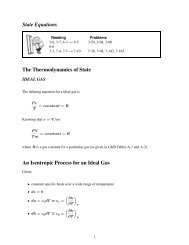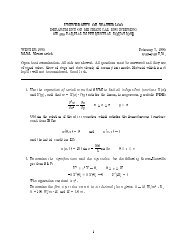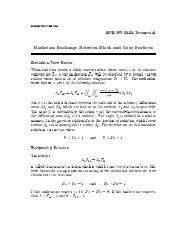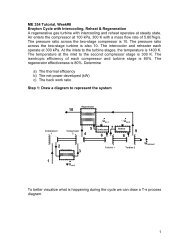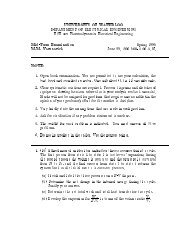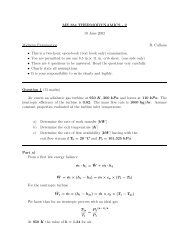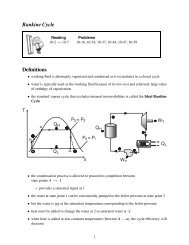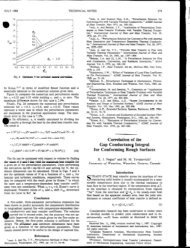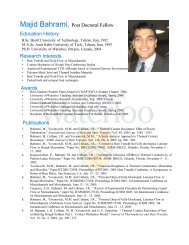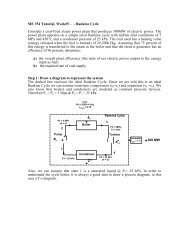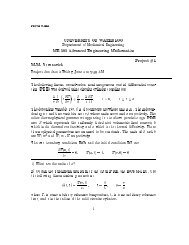Adobe PDF - Microelectronics Heat Transfer Laboratory
Adobe PDF - Microelectronics Heat Transfer Laboratory
Adobe PDF - Microelectronics Heat Transfer Laboratory
Create successful ePaper yourself
Turn your PDF publications into a flip-book with our unique Google optimized e-Paper software.
WK4TPCSWEB.TEXME 353 M.M. YovanovichWeek 4Lecture 1Hand out Project 1. Due Friday, October 16, 12 Noon. Extended surfaces or ns; temperature is one-dimensional T (x) when Bi =ht e =k < 0:2 where the eective n thickness is dened as t e = A=P ; where P isthe constant n perimeter and A is the constant n conduction area.See Web Site for derivation of general n equation and general solution for nswith contact conductance, h c , and end cooling, h e ;solution (x) =T (x) , T f , called the temperature excess, is a function of dimensionlessparameters: Bi c = h c L=k; Bi e = h e L=k; mL with n parameter:m = q hP=(kA)P is the constant n perimeter and A is the constant n conduction area. Fin resistance: R n = b =Q ; b = T b , T f . Special cases of the general solution:(a) perfect contact at n base: Bi c = 1 and end cooling: Bi e > 0(b) perfect contact at n base: Bi c = 1 and adiabatic end: Bi e =0;(c) perfect contact and innitely long n. Criterion for innitely long n: L crit =2:65=q(hP=kA)When L>L crit , model n as innitely long, and when L
? conduction rate out of CV at x + dx is Q x +(dQ x =dx) dx,? convection loss is dQ conv = hP dx(T (x) , T f );? no sources, steady-state;? derive governing second-order ordinary dierential equation.see section 3.6.2 for derivation of ODE and boundary conditions at x = 0 (perfectcontact) and x = L (convection cooling). See Table 3.4 for summary of solutions. See Table 3.5 for summary of n eciencies: f for various n types.Lecture 3Review of material on Web site for derivation of general n equation valid forvariable conduction area, A(x), and variable perimeter, P (x); introduce temperatureexcess: (x) = T (x) , T f ; note that d=dx = dT=dx because T f isconstant; consider special case: A and P are constants;n equation becomes d 2 =dx 2 , m 2 =0 in 0
pR fin =1= hP kA tanh mLperfect contact p at n base and innitely long n:R fin =1= hP kAn eciency: f = Q n =Q ideal ;Q ideal corresponds R to an ideal n whose thermal conductivity is innitely largeLQ ideal = hP 0 b dx + h e A b =(hP L + h e A) bspecial cases of general solution with perfect contact at n base:h c = 1 or Bi c = 1;three options at the n end:(i) end cooling h e > 0orBi e > 0;(ii) adiabatic end: h e =0orBi e =0;q(iii) innitely long n, i.e. L>L crit =2:65= hP=kA;see Web Site for several special cases.Longitudinal ns; pin ns; circular annular ns; analytical solutions for severaltypes of ns; see Table 3.5 for eciencies of common n shapes.Applications of n solutions: example 1 is a circular rod of length 2L which connects two walls at temperaturesT 1 and T 2 which are greater than air temperature T f ; there is convectivecooling from the sides of the rod into the air. Assume perfect contact at theinterfaces between the rod and the two walls.special cases:(i) when T 1 = T 2 , the plane of symmetry (adiabatic plane) occurs at mid-point(ii) when T 1 >T 2 , the plane of symmetry moves to the right of the mid-point(iii) when T 1



